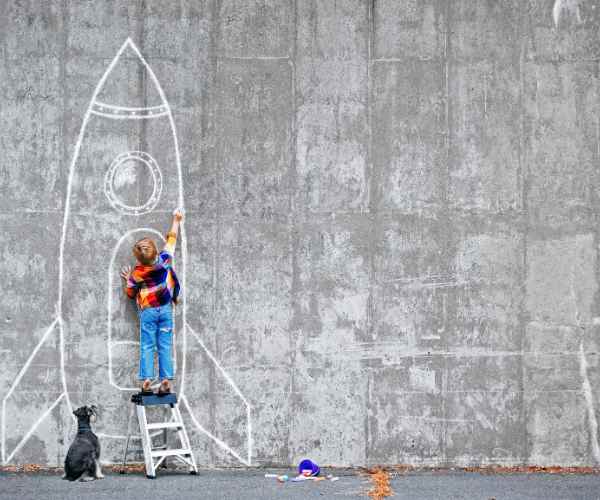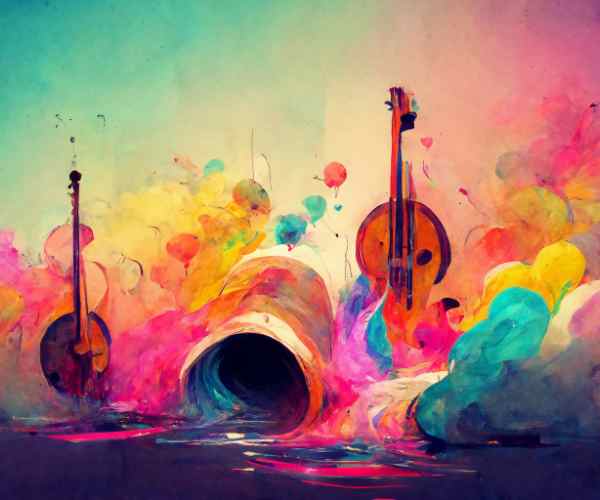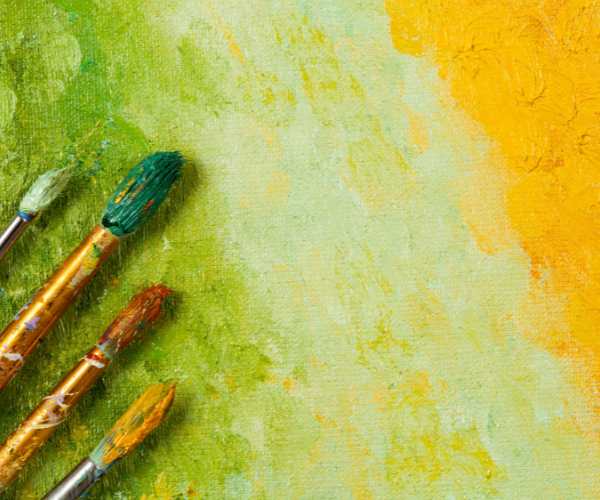It is a peppy word where the imagination roams free. It is not just an exercise of the mind to talk about the effect of dreams on art.
My foray into the world of dreams and art began while I was visiting a small gallery. I was looking at a striking painting that I have never seen before. It was so graphical in terms of color and form that it was almost breath taking. After looking at the piece, I read the artist statement and realized that this was too much of a realization for me – looking at the life and seeing it suddenly gives rise to a creation, a wonderful creation. To every extent, it looked like it was a painting which was digitized and for me it was entirely new.
Artistic expression has its roots in dreams, which is not hard to realize – at the core of almost every artistic achievement dreams lie. From prehistoric cave art depicting the starry night sky to modern-day surrealist work, dreams have inspired many artworks. Hence, during the night, how many of us dream and how many of artist draw inspiration from it? This will be the main topic of this post as I go on to highlight how dreams influence creativity, some great artists who have ventured deep into these realms, and some of their dream based work.

How dreams inspire creativity
The Subconscious Mind at Play
When we mention dreams, we are referring to our subconscious. The part of our mind that is filled with ideas, feelings, and even pictures that evaporate as soon as we awaken.
To an artist, this world we cannot see is a goldmine of creativity. This is best illustrated by Salvador Dalí, who sought out dreams for inspiration and allowed himself to create anything free of boundaries. As he explained his nightly visions, Dalí had an unconventional outlook – Most of his paintings consist of bizarre and dream-inspired scenery that goes against the laws of reality.
I find it interesting that he would use the nonsense produced in his dreams to create a fitting visual representation. It’s as though he wanted to share his dream with everyone, showing them its weirdness and beauty – He is inviting people with words as, “See, this is how I dream, what are your dreams like?”
Conclusion: How Does He Do It With His Dream or with His Imagination?
Converting the dreams into visual arts especially for the autistic kids to accelerate their emotional development is a creative process which is personal to each individual.
Many artists have a tendency of capturing the moment when they wake up from sleep or daydreaming by maintaining a subconscious diary or a journal. The practice of capturing the moment by quickly writing down the fleeting feelings and images enables that ethereal essence to live on. To put it differently, the moment is prevented from perishing.
Frida Kahlo is the most appropriate example when it comes to an artist who was able to merge the two worlds of imagination into one tangible piece. More often than not, her paintings embody her dreams and memories and thoughts transforming her into a world of symbols and emotions while covered in her paintings.
The funds provided her with endless possibilities, with the gift of filming and freedom, and the gift of surrealism can undoubtedly be observed in her work “The Two Fridas.” She expresses her duality using dream-like images in this piece. It appears as though she is piecing the puzzle together of how her dreams and her real world flow together while she unearths her intricacies. Merely seeing her art is an experience that brings you in contact with her emotions, her challenges, and hopes.
Kahlo’s works always touch the heart as she gives breath and life to the translated dreams of her. To us, her art demonstrates that those dreams do have a connection to the real world, and that they can be used to heal us by linking the inner self with that outside reality.
Absolutely! Here’s a detailed, conversational style write-up for the Notable Artists Influenced by Dreams and The Impact of Culture and History on Dream Inspired Art sections, in the voice of Elena Martinez, as she expresses her reflections and opinions.
*Notable_Artists_Influenced_by_Dreams*
Salvador Dali : The Master of Surrealism
Salvador Dali and his surreal paintings are the next topic to paint but in my imagination that is even more surreal than his imagination paintings.
One such painting is “The Persistence of Memory” which is of great importance to understanding fashion because it is inspired by dreams. Those clocks are melting clocks-remember them and the trees with the stones and the picture that surrounded it- is it not the picture that represents something rather strange? After all, every dream has its own feeling once it is merged with reality.
Though dreams occur in the realm of the unconscious mind, have no linear time or space, and appear illogical, Dalí’s strange imagery gives us a clearer understanding of dreams and what they signify. He developed a visual language that enables and encourages people to interpret the images. It is as though he was inviting us to imagine and contemplate our dreams as we experience his images. I recall being in a museum and staring at the painting. I felt a force as strong as a magnet pulling me towards it as if it were a clock trying to tell me its meaning.
For Dalí’s purposes, dreams aren’t merely paintings; they’re representations of what we want to strive for. He blurred the line between what’s beautiful and what’s bizarre, and encouraged us to capture the wonders of the hidden corners of our mind. This and his work reminds us all how absorbing one’s dreams can be and why they are often so blurry.
Frida Kahlo: An Examination of Self through Broadcasting Dreams
Then you have Kahlo; for her, art is an amalgamation of love and healing. She paints as though she is vulnerable and brazen, often using her dreams as metaphors for her painting’s motifs and stories.
Kahlo’s self-directed paintings are mirrors, gazing into them reveals something within. Each single image narrates something sensual in some way, a time and sequence within her. I still remember, as if it happened recently, my very first encounter with Frida‘s two characters in “The Two Fridas.” The European and Mexican gowns worn by the two figures mitten together helped me understand duality. It was like I saw psyche, where dreams led to pain and even more complex feelings.
More than just pouring pain onto the canvas, Kahlo’s strategems showcase her struggle – perhaps even more than her pain did and this is the reason her work depicts turbulence on so many levels. Her dreams also become images that emphasize the aesthetic feeling that is hidden in her subconscious mind. It’s like she is showing her dreams and pain so that someone out there may remember and relate to theirs.
Vincent van Gogh: The Nightingale’s Influence
And there is Vincent van Gogh, too — the artist with whose work exhibits the emotional chaos sometimes typical of human existence. “Starry Night” is one of his most famous work and theme in which color and feeling are often dreams is best illustrated.
One can easily loose perspective looking at the blue and yellow tones in the beautiful sky of this painting. They produce a dreamlike effect which describes the state of emotion van Gogh was in. Why as I seem to ask often, he swirled those clouds on canvas what was his mind in? It so often seems to me that he was conveying his emotions on the canvas which served as the background to his dreams and feelings.
The feeling expressed in the painting “Starry Night” does make one think for a moment, controlling one’s fantasies, for dreams are often chaotic, yet beautifully subtle. Van Gogh is with color and paint able to give wings to the height of his spirit, which gives a clear indication of the dream frequency with which the emotional landscape is so closely unified.
The Influence of Culture and History on Dream Related Artwork
Dreams And Dreaming In Ancient Cultures
The concept of dreams has always been intriguing to people.
During in those ancient societies they were considered as messages from God. Imagine for a moment what the ancient Egyptian or Grecian societies did with their dreams. They kept a dream diary of sorts, because they thought these dreams had something insightful to say about life.
Dreams determined the nature of art works as different as pottery and frescoes. It is amazing to me how a single vivid dream could awaken imaginations that would create elaborate carvings or paintings that would eventually endure through time. These artworks served a great purpose; they were not simply decorative pieces, they were intensely symbolic and meaning bearing and closely related to the society’s beliefs and customs.
A dream was considered as a pointer directing an artist to pieces he was supposed to create. This is a nostalgic appeal of how dreams have the ability to not only influence self-representation but also the culture as a whole.
Current Art on Dreams
We now live in a time when we do not need to consult psychics for us to comprehend dreams, so it’s good to know that psychology has advanced in recent centuries. To imagine that there was previously such a differentiation – between our current views on dreams and their treatment by the artists of the past.
People no longer limit themselves to the mystery of dreams – to their irate power, which apparently rules the world; they begin to consider what gives rise to them, what causes these dreams to appear in our brain. Dreams are now accepted as normal occurrences and are meticulously considered and assessed.
Modern artists, for example, take aspects like anxiety, identity, and the body into account when making work. Contemporary artists, for instance, employ their dreams and examine social issues in their work. These are pieces that people can see themselves in context to them, which is great.
This development creates the possibility of discussing dreams more broadly in connection with their artistic aspect, considering them not only from the perspective of individual experience but also as common topics. It reminds us that it has always been and always will be that dreams are part of whatever expression artistic or otherwise, creative or non-creative.
Frequently Asked Questions
Are there recurring themes found in dream-based art?
It is equally interesting to analyze the general features of the art works created by the dreams.
We often daydream or fantasize about abstract identities.
There is that the consciousness and the self are often an obstacle to or a goal for many.
I remember reading about how Frida Kahlo used her self-portraits to grapple with this indefinable question. Her dreams illustrated her controversies and struggles and that is clearly seen in her colors and images. This is another of her central themes.
Another theme is surrealism.
Only it is so incomprehensible and so illogical as poems often tend to be, and all closet familiar images and scenes are there but of course in a different manner. Consider Salvador Dalí and his unending clocks! Can art in all its forms have anchors and directions?
There is mother nature however, more artist usually draw from this, as whom in their dreams where not taken to another beautiful location or even an intimidating one.
At last, depression sutra anime are clearly perceived. The founders of the first film used to pour their anxiety, fears, and desires into their creations hence throwing tantrums.
There are works I have come across in which the rawness of emotions is expressed on the canvas and helps the viewer to understand the artist’s subconscious.
And how do I go about putting my visions into art pieces?
Incorporating your dreams into art can be an incredibly rewarding experience!
A great way to start is by keeping a dream journal.
Trust me when I say this, this task has been immensely beneficial to me.
As soon as you get up from your bed each day, try to record all the events that took place in your dreams.
Even if the thoughts just consist of fragments of images or emotions, it is important to note them down.
It is astonishing how quickly these multi-dimensional entities become non-existent!
Once you’ve recorded your dreams, try to spend some time sketching or writing about them.
Do not aim for perfection rather aim for feeling.
Try to imagine them, as absurd as they might sound to you.
If dreaming of those abstract things then what colors or shapes might come into your head when doing so?
This investigation can assist you in rewriting certain details that draw from your deeper mind.
Small sketches can be your first step or playing around with various types of media for a start.
I assure you that the more you tend to those image fantasies, the more they are going to be closer to your heart in regards to the creative works.
Are there certain methods that are employed by artists in order to illustrate dreams?
Most Definitely!
Such methods have been formulated by painters in order to express those qualities of dreams that stem from the emotional experiences of their subconscious.
One such technique involves dream and surrealist paintings, where artists seek to depict an illogical theme and attempt to construct a view that seems fetched from imagination.
Think of Dalí’s paintings that constructed in his head for he would bend daily items to fit a vision of an uncanny scenario.
Using abstract figures is another way round.
This may involve changing the position or color of the shapes simply to invoke a general sentiment instead of a defined visual depiction.
In stepping outside representational art approach, they can express symbolism and fluidity of dreams.
I’ve seen artists play around with layering of different materials in their works which complements the often distortional nature of various pieces.
Symbolism is another significant area that should not be neglected.
In this perspective, artists embrace symbols which are of considerable importance to themselves, thereby speaking their visual language.
For example, a door key could stand for a door containing new ideas or memories.
This method deepens the interests of viewers to the art and leaves them with a comprehension of it that is based on their perception of dreams.
Conclusion
Finally, as we seek into the connection between dreams and art, we find that such a relationship exists.
Dreams are more than just some images and thoughts we get while sleeping, they are extremely important and represent a part of our mind.
Whether it is Salvador Dali and his absurd intersected reality, or Frida Kahlo with her self-engineered stories, artists use dreams for further steps in the art creating and for experiencing a wider range of feelings.
Such pieces show us, that dreams could be the reason for an entirely different form of creative inspiration.
With this in mind I would like you to think about the dreams that you have had and how they could be turned into an artistic vision.
What stories do you have in your subconscious that have yet to be told?
You should start believing in those dreams to make the best out of your artistic side.
In the end, It would suffice to say, our dreams contain a wealth of ideas waiting to be unveiled!




